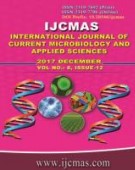


 National Academy of Agricultural Sciences (NAAS)
National Academy of Agricultural Sciences (NAAS)

|
PRINT ISSN : 2319-7692
Online ISSN : 2319-7706 Issues : 12 per year Publisher : Excellent Publishers Email : editorijcmas@gmail.com / submit@ijcmas.com Editor-in-chief: Dr.M.Prakash Index Copernicus ICV 2018: 95.39 NAAS RATING 2020: 5.38 |
In the present study, autotrophic ammonia- and nitrite- oxidizing bacteria (AOB and NOB respectively) were enriched and methodically added to treat ammonia laden effluent (700 ppm) of a fertilizer industry with exceedingly low C: N ratio. An open aerobic reactor system of 5.3 L was developed and run in the batch mode for the first 30 days to acclimatize the biomass with increasing effluent concentration. A linear correlation was observed during the batch mode between the amount of ammonia oxidized and the ammonia loading rate (R2 0.79). On making the system continuous, 99% NH4+-N removal was achieved along with complete utilization of indigenous carbon without accumulation of NO2--N and NO3--N. Molecular microbial analysis showed presence of AOB belonging to Nitrosomonas sp., NOB belonging to Nitrobacter sp. and aerobic denitrifiers mainly Achromobacter sp., Sphingomonas sp., Pusillimonas sp., Mesorhizobium sp. and Alcaligenes sp. coexisting in the system. Their concerted growth and simultaneous aerobic nitrification denitrification (SND) activity led to efficient removal of nutrients from the effluent and suggested high potential of the developed system in bioremediating industrial effluents with low C: N ratio.
 |
 |
 |
 |
 |